One Setian’s opinion on how certain media depictions of Set hold up against the real-life God.
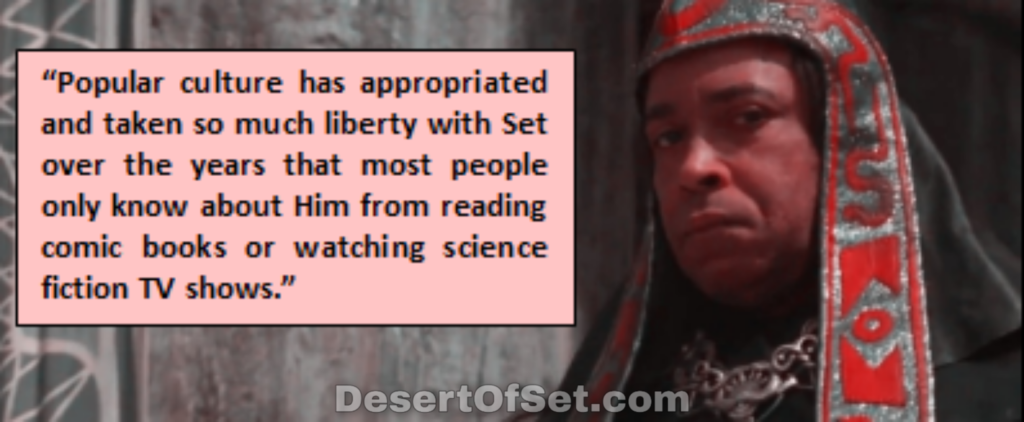
Sometimes when people find out I believe in Set, they ask me how I can possibly believe in a “fictional character” from Doctor Who or Marvel Comics. Occasionally, I’m even asked if I think I’m some kind of vampire. This really gets on my nerves, but I suppose I can’t blame the people who ask such questions. Popular culture has appropriated and taken so much liberty with Set over the years that most people only know about Him from reading comic books or watching science fiction TV shows. Inevitably, Set is always cast as a villain in these and other popular media, and this compounds the problem by leading people to think I’m some kind of “devil worshipper.” (This isn’t helped by the fact that Set is so often appropriated in Satanist legitimation strategies, wherein Satanism is re-conceptualized as something “pre-Christian”—but we’ll address that particular can of worms another day.)
There are various forms of popular media that I consider to be very Setian indeed. However, the evocation of Set in these media is most often unintentional; He is to be divined in the subtext rather than the text. In most creative works that actually mention Set by name, there is little to nothing of His actual presence to be found. Allow me to show you just what I mean.
Set in Robert E. Howard’s Conan Cycle (1930s)
Set is most often conceptualized in pop culture as some kind of “evil snake God.” This is ironic given that He’s actually a mammalian God who’s primarily associated with herbivorous artiodactyla (i.e., cloven-hoofed animals). But it isn’t hard to see where the “snake God” idea came from. By the time the Greeks were in control of ancient Egypt, Set was completely demonized by the Egyptians. They blamed Him for the decline of their civilization, and they deliberately confused Him with His enemy, the monster Apep. When the Greek writer Plutarch started writing his own account of Egyptian mythology, he identified this fusion of Set and Apep with Typhon, a monster from Greek mythology. Plutarch’s version of events was taken at face value by many of the early Egyptologists; it wasn’t until the publication of Herman te Velde’s Seth: God of Confusion in the 1970s that more accurate information about Set started becoming available. So when Robert E. Howard drew from pre-Christian mythology for his stories about Conan the Barbarian during the 1920s, the “evil snake God” idea was still in vogue.
Set is cast in Howard’s tales as a gigantic snake from outer space that was originally worshiped by a race of alien Serpent Men. He plots to cause the extinction of humanity so these Serpent Men can rule the Earth once more. I really enjoy Howard’s Conan stories, but I can’t help but laugh at this fictional version of Set. If you’re a Christian, imagine what it might be like if Jesus appeared in a story as a giant alien goat that just wants to eat everybody. That would be pretty silly, right? (I mean, Set could appear as a giant snake and eat everybody if He really wanted to; but…)
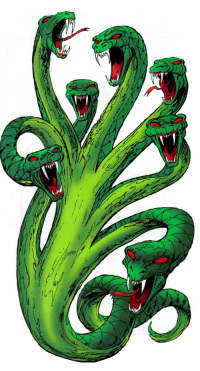
Robert E. Howard’s Set, as depicted in Marvel Comics
So is there anything of the real Set in Howard’s fiction? Actually, I would say yes…but not in the form of Set the Stygian snake God. I would contend that Set’s true nature is better revealed through the character of Conan himself, a nomadic anti-hero who rejects the authority of kings and priests. He’s primarily interested in his own gain, but he also rescues the innocent and defeats frightening monsters…just like Set. In one particular story, “The Tower of the Elephant,” Howard describes some of Conan’s feelings about the organized religions that are practiced in his world, and I believe his views on this subject are in keeping with Set’s:
He had entered the part of the city reserved for the temples. On all sides of him they glittered white in the starlight—snowy marble pillars and golden domes and silver arches, shrines of Zamora’s myriad strange gods. He did not trouble his head about them; he knew that Zamora’s religion, like all things of a civilized, long-settled people, was intricate and complex, and had lost most of the pristine essence in a maze of formulas and rituals. He had squatted for hours in the courtyard of the philosophers, listening to the arguments of theologians and teachers, and come away in a haze of bewilderment, sure of only one thing, and that, that they were all touched in the head.His gods were simple and understandable; Crom was their chief, and he lived on a great mountain, whence he sent forth dooms and death. It was useless to call on Crom, because he was a gloomy, savage god, and he hated weaklings. But he gave a man courage at birth, and the will and might to kill his enemies, which, in the Cimmerian’s mind, was all any god should be expected to do.
—Robert E. Howard, “The Tower of the Elephant”
I don’t think it’s “useless” to call on Gods for help (and there are times in the stories when even Conan must do so), but I do agree that spirituality should be kept as simple and practical as it possibly can. The fact that Conan thinks this way makes sense, since he’s a nomad. He doesn’t have time to sit around and discuss theology; he only cares about what works at any given time. Who cares whether the Gods are spirits, aliens, or Jungian archetypes so long as our prayers and rituals to them continue to work? And since Set’s most ancient worshipers were nomads who lived in the Sahara Desert, I believe they would have thought in much the same terms. I try to keep this attitude as well, eschewing theological arguments in favor of whatever works to get me through the struggles I must face. In this sense, I believe there really is quite a bit of Set in Robert E. Howard’s fiction; just not in the way you might expect.
Set in the Marvel Universe (1970s)
In the 1970s, the Marvel Comics Group was licensed to print its own stories based on Robert E. Howard’s Conan character, and it incorporated Conan’s world into its own unique universe. As a result, Howard’s version of Set was expanded upon and became an integral part of Marvel’s lore. According to this version of events, Set originated as one of the Elder Gods at the beginning of time, and He became evil by cannibalizing His own kind. Then, to escape from the vengeance of a younger God called Atum (who’s named after Atum-Ra), He slithered away into an alternate dimension. (Yes, this Set is still a giant snake.) Unfortunately for Set, He can’t escape this dimension by Himself, but must instead procure servants in this world to help facilitate His return. This role was originally filled by the Serpent Men of the Conan stories, but Set would also recruit followers in the twentieth century. This, in turn, would lead to several confrontations between the followers of Set and such well-known superhero teams as the Avengers.
Confusingly, Marvel Comics also created another fictional version of Set who is identified as being the actual Egyptian God (as opposed to the Stygian God). He’s a recurring villain in the Thor comic books, and most of His role in the Osirian myth cycle is kept intact. He actually tricks Osiris into a coffin, then drowns Him in the Nile and dismembers Him. Naturally, Marvel built upon this story in certain ways to integrate it with its universe (and they conveniently removed all the parts about Set defending Atum-Ra from Apep). But the strangest twist is when Seth supposedly tricks mortals into worshiping Him by transforming Himself into a giant snake and pretending to be Set (i.e., the snake God of Howard’s Serpent Men). In other words, a demonized version of Set pretends to be another demonized version of Set to gain His followers.
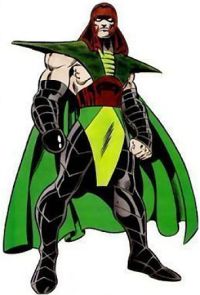
Seth—as opposed to Set—in Marvel Comics.
If that doesn’t strike you as sounding completely nonsensical, let’s switch the names again. Not only is Jesus really a giant space-goat who wants to eat everybody; now there’s another, less-powerful Jesus who impersonates the space-goat Jesus so that people will worship him. (Huh?)
Set in Doctor Who (1975)
Big Red appears in the episode Pyramids of Mars as Sutekh, an alien tyrant from the planet Osiris. (Yeah.) He destroyed His own people and planet aeons ago, but then He was imprisoned by His brother Horus in a tomb on the planet Mars. When Pyramids of Mars begins, Sutekh uses His telekinetic powers to possess a guy here on Earth in the early 20th century. He then makes the guy build a bunch of robot mummies, as well as a rocket. The plan is for Sutekh’s hypnotized slave to fire that rocket straight into Sutekh’s prison on Mars. This will effectively release Sutekh from His prison, allowing Him to resume His dastardly plan of atomizing the entire universe (for no apparent reason). Thankfully, our favorite Gallifreyan Time Lord, the Doctor (played here by Tom Baker), is on the case. (And since this episode aired in 1975 and Doctor Who is still being produced four decades later, I’m sure you can guess how things turn out for this version of Big Red).
Though the writers of Pyramids of Mars clearly didn’t know (or care) that much about Set or Egyptian mythology, there are a couple of things going for this version of Sutekh as defined by the BBC. For one thing, at least they had the good sense to depict Him with the head of His sacred sha beast; I can appreciate this over depicting Him as a giant snake. For another, Sutekh is played by Gabriel Woolf, who has the coolest-sounding supervillain voice ever. (Woolf would later return to voice the character of “the Beast” in 2006’s The Impossible Planet/The Satan Pit.) If you’re going to make Set a villain, at least make Him impressive and charismatic like Doctor Who does. I for one think it would be pretty awesome if they revisited this character in a future episode.
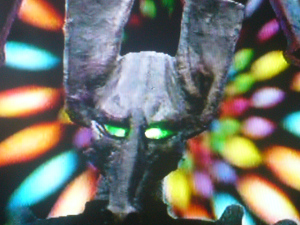
Sutekh the Destroyer from the planet Osiris (without mask)
Set in Conan the Barbarian (1982)
In this magnificent film adaptation of Howard’s Conan stories, the villain is a wizard named Thulsa Doom (played by James Earl Jones), who is actually two characters in one. Thulsa Doom was originally the name of a very different villain in Howard’s Kull stories, an undead necromancer with a skeletal face. (Actually, Skeletor from the 1980s He-Man and the Masters of the Universe cartoon is basically a child-friendly version of Thulsa Doom.) The Doom in this movie is actually Thoth-Amon, a Stygian sorcerer and priest of Set who was Conan’s arch-nemesis in the original stories. I have no bloody idea why the filmmakers decided to mix up the characters’ names like this, as it serves no rational purpose that I can see. But it doesn’t matter that much, because the movie is still awesome to behold (and Jones’ performance as “Doom” is simply amazing).
In this film, it remains unclear as to whether Howard’s Set (or any other God) actually exists or not. The film does hint that the Set cult has existed for much longer than Thulsa Doom has, but the cult doesn’t appear to have any substantial interest in facilitating Set’s return to their dimension. If anything, Doom seems to have appropriated the cult and turned it into a vehicle for his own personal gain; one might even say the cultists are far less interested in worshiping Set than they are in worshiping Doom himself. And as far as I can tell, they don’t do anything aside from practice cannibalism, throw wild sex orgies, and feed naked women to giant snakes. Honestly, this is more of a commentary on dangerous cult leaders like Jim Jones than a straight adaptation of Howard’s fiction. That being said, I actually like this version of Howard’s Set cult much better. It wasn’t necessarily evil from the beginning, nor does it necessarily follow an evil god; it’s just been twisted to fit an evil wizard’s agenda. (Though I will admit that it’s pretty damn cool to hear James Earl Jones preach about how “THE EYE OF SET IS UPON YOU!”)
I do believe there are messages from Set in this film; but as with the original Conan stories, they’re to be found in the character of Conan more than in Thulsa Doom. If anything, I think the story is telling us that Set doesn’t like it when power-hungry madmen like Doom appropriate His worship for such horrific ends, and that He actually favors people like Conan. In fact, it’s possible to interpret Conan as a warrior chosen by Set to cleanse His religion of Doom’s twisted fanaticism.
Set in Conan the Adventurer (Animated, 1993)
In the 1990s, there was an animated Conan series. In this adaptation, Set is clearly real and can actually act upon Conan’s world. (He’s even played by a voice actor!) Set appears as a gigantic talking cobra that comes from some alternate universe and that wants to take over the world. Long ago, He was banished to “the Abyss” by damn near every living wizard on Earth; but Set has His own wizard, Wrath-Amon, whose mission is to collect what he calls “Star Metal.” This is a magical glowing iron that comes from meteors and that can apparently open doorways to interdimensional worlds. This is a rather interesting idea, considering that iron (especially meteoric iron) is quite sacred to the real-life Set and is used in His worship to “open the mouths” of physical objects (which turns them into magical “interfaces” with the spirit world).
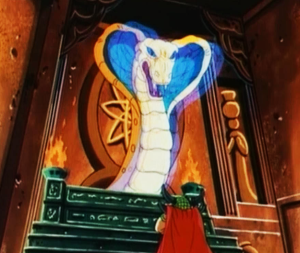
Enough of the “giant snake” thing, already!
Wrath-Amon is clearly based on Thoth-Amon from the original Robert E. Howard stories, but they decided to change his name and turn him into a Serpent Man (rather than let him be a regular human, like Thoth-Amon). This begs the question; just what the hell is so difficult about adapting the Conan stories into movies, cartoons, or even TV shows? Why is it that every cinematic adaptation has to mix characters up or reverse their names or give them names that are kind of the same, but slightly different? Is there a law somewhere that says they have to do this?
Set in G.I. Joe (Animated, 1985)
Believe it or not, Set—as well as Osiris, Horus, Thoth, Buto, Ammut, Ma’at, Amun-Ra, Sekhmet and Anubis—appears in a 1985 episode of G.I. Joe called “The Gods Below.” The plot of this episode concerns an Egyptologist who’s discovered “the Tomb of Osiris” and who is then kidnapped by the terrorist group, Cobra. Cobra Commander and the Baroness hope to plunder the treasures of this tomb to fund their next evil plan, and somehow the G.I. Joe team catches wind of this. Before you can say, “Raiders of the Lost Ark,” the Cobras and the Joes are running around inside Osiris’ tomb, firing bazookas at each other (and somehow not causing the entire structure to cave in on them). They do succeed in attracting the attention of the Netjeru, however, and the Joes are tested in the court of Osiris to determine their moral worthiness. Meanwhile, the Cobras encounter Set and try to trick Him into giving them the treasure they seek. They do this by pretending to worship Him, but Big Red sees right through their bullshit and stomps their asses with a powerful thunderstorm.
Set is of course described as “the God of Evil” by several characters throughout this episode, but He actually helps to stop Cobra in the end, and He does so without harming anyone. Even better, He’s depicted in His proper form as a big muscular dude with the head of His holy sha beast. He does take the form of a gigantic serpent at one point, but it’s clearly indicated that this isn’t His true form, and the context in which this occurs is quite remarkable. When the Cobras first encounter Him, Set asks if they are “worshipers of the Serpent.” They say yes, and He transforms Himself into a big snake and commands them all to kneel. They do so, and Set changes back to His sha form and gives them the treasure. Then the Cobras leave, and Set attacks them in the sky while they’re flying away. The way I read it, this whole exchange is a trick to see if the Cobras really know what it means to worship Set. By kneeling before Him while He’s in snake form, they prove that they know nothing about Him and that they see no difference between worshiping Him and worshiping His enemy, Apep. This, in turn, incites Big Red to smite the rotten bastards just when they think they’ve won.

Big Red actually looks kind of cute here!
As a Setian, I think that’s pretty fucking awesome! I love G.I. Joe, and I really love this episode. Who would have thought that a simple-minded cartoon from the Reagan era would contain one of the very best representations I’ve ever seen of the Red Lord in Western pop culture?
Set in the Puppet Master movies (1989–Present)
Oh, boy.
So the Puppet Master franchise is a series of cheap direct-to-video horror films that are produced by Full Moon Entertainment, which was probably the King of direct-to-video schlock in the 1990s. Have you ever seen the Trancers, Dollman, Demonic Toys or Subspecies movies? They’re all Full Moon flicks, and Puppet Master, like the rest of them, barely qualifies as “horror.” These flicks are more like unfunny comedies that just happen to include healthy portions of gore and sleaze. It’s impossible to take them seriously; but as long as you don’t try, some of them can actually be pretty enjoyable. That being said, the Puppet Master movies concern the legacy of Andre Toulon, a French alchemist in World War II who discovers a magic elixir that can bring inanimate objects to life. When the Nazis kill his wife, Toulon gets revenge by bringing his puppets to life and sending them to bleed those fascist bastards dry. Then Toulon and his puppets relocate to America, where the puppets cause more trouble long after Toulon’s death.
It just so happens that one of the villains in this series is Set, who’s known here as Sutekh (as in Doctor Who). And to be honest, this has to be the most original design for Big Red that I’ve ever seen in any movie (though I don’t mean that as a compliment). Full Moon’s Sutekh resembles a pudgy BDSM Buddha with a face that looks like a skull carved out of a spoiled cabbage. He also has two glowing Florida oranges for eyes, and He even has nipples. (Nipples, I say!) Apparently, this version of Set is responsible for creating the magic elixir that gives Toulon’s puppets their life, and He wants it back so He can use it to unleash the apocalypse somehow (naturally). Of course, Sutekh is trapped in some kind of alternate dimension (I wonder where they got that idea), and He’s only powerful enough to send really tiny versions of Himself into our world. These miniature clones are called “Totems,” and they’re just about the same size as Andre Toulon’s puppets (which means we get to see lots of puppet vs. puppet action).

Where the hell did THAT come from?
I have to hand it to Full Moon Entertainment; at least they didn’t take the lazy way out and go with the “Set is a giant snake” idea. But this particular version of Big Red is so bizarre, I can’t even figure out where it came from. At least the Sutekh in Doctor Who actually looks like Set (complete with those cute rectangular ears of His). But how the hell did they come up with the idea for a bald, naked potato-man Sutekh with glowing googly eyes? (And one who can only get hokey-looking 3-inch dolls to do His bidding?)
Set in Vampire: The Masquerade (1991)
In the role-playing game, Vampire: The Masquerade, there’s a clan of vampires known as the Setites or the Followers of Set. Unfortunately, Set is defined not as a God in Masquerade lore, but as an Antediluvian vampire (i.e., a vampire from before the biblical Flood) who has merely set Himself up to be worshiped as a God (and as an evil “snake God,” to boot). You see, Masquerade posits that all vampires are descended from Cain (i.e., the biblical son of Adam and Eve who slew his brother, Abel). According to this thesis, Set is just one of thirteen vampires that were later created by Cain’s immediate descendants, Enoch, Irad and Zillah. In other words, Masquerade is saying that an ancient Egyptian God was brought into being by a rejected biblical patriarch—and while I wouldn’t go so far as to say that I find this idea “offensive,” I do think it’s pretty ridiculous. (I don’t care if this isfiction; Gods trump vampires, and Set trumps Cain.)
In the game, Setite vampires have special interests, abilities, and weaknesses that are not necessarily shared by other vampires, and this is due to their descent from Set. Their main interest is in spreading as much corruption in as many different areas of life as they can (e.g., promoting crooked politicians, funding terrorist organizations, supporting the snuff film market, selling hard drugs to little children, etc.). They also have a discipline called “Serpentis,” which is the ability to control or take on aspects of snakes. Their greatest weakness is that they are far more sensitive to light than almost any other kind of vampire; they can even be harmed by strobe lights. Apparently, their obsession with ruining the world is all part of their religious devotion to Set, whom they believe is still alive and sleeping somewhere deep in the Earth, waiting to return at some future time when He will destroy the Sun (thus liberating all Setites forever). As such, the Setites are something like the Islamic State of the Masquerade world; they’re just a bunch of dangerous religious fanatics whose ultraviolent activities don’t make any sense.
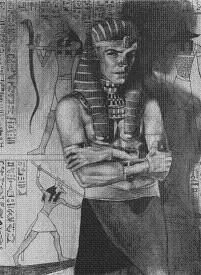
I’m guessing this is what Set “really” looks like in this game.
I know there are people out there who really enjoy Vampire: The Masquerade and who are especially interested in playing as Setite characters. That’s all well and good, I suppose, and I know Big Red doesn’t really care what some role-playing game has to say about Him. But while I can forgive someone saying He was created by a Bible character, I find all this stuff about “corruption” to be pretty damn offensive. Just in case there are any Masquerade players reading this, I’d like to you to know that the real Set has nothing to do with that stuff. He might have killed Osiris, but it was a necessary event in the Creation of the universe. (How else could Osiris rise from the dead if He didn’t die first?) Furthermore, Gods killing Gods is very different from mortals killing mortals; we all know that it isn’t a good idea to re-enact what professional wrestlers do in our own living rooms, and the same principle applies here. I might also mention that Set only killed Osiris once; as the Defender of Ra, He rescues us all Apep every single night. So regardless of the value judgments that people might attach to Set’s role in killing Osiris, that role is secondary to His primary job as a Savior God.
Also, real-life Setites are not evil people who want to ruin the world and destroy the Sun. We’re just like everybody else; we have families, we work jobs, and we try to live as best we can. Many of us are environmentalists (especially those of us who identify as Pagans), and even those of us who walk the left-hand path are usually humanitarian to some degree at least. Do you know where this whole idea of wanting to ruin oneself and murder the world really comes from? It comes from Apep, which is the arch-enemy of Set (and, indeed, of all Gods and creatures). The things that Setites are supposed to do in Vampire: The Masquerade are not Setian at all, but are utterly qliphothic instead. Now I’m not trying to launch a personal crusade against White Wolf Entertainment or anything like that, but I do think that linking Set worshipers to things like terrorism and the snuff film industry is going a bit too far. And since I’ve never seen anyone else come out and criticize Vampire: The Masquerade for doing this, I decided to go ahead and scratch this off my bucket list.
(I might also mention that the word Setite is not the intellectual property of White Wolf Entertainment. To the best of my knowledge, it first appears in E. A. Wallis Budge’s From Fetish To God in Ancient Egypt, which was originally published in 1934. In that book, Budge uses the word in reference to people in ancient Egypt who worshiped Set. Now I’ve never met a real Set follower who actually wanted to call him or herself a Setite, and this is probably because we all know it would lead people to confuse us with the fictional vampire clan. But just in case anybody out there really likes that word, I just want everyone to know that it pre-exists Vampire: The Masquerade and that it was actually coined by a real life Egyptologist.)
Set in Stargate SG-1 (1997 – 2007)
Stargate SG-1 is based on the popular 1994 film Stargate, which was directed by Roland Emmerich and written by Dean Devlin (i.e., the same team that brought us 1996’s Independence Day and the horrifically awful 1998 version of Godzilla). This is the one where Kurt Russell and James Spader walk through an ancient intergalactic wormhole machine that spits them out on another planet that looks like ancient Egypt, and which is ruled by hostile aliens that claim to be the Egyptian Gods. In SG-1, Richard Dean Anderson plays the Russell role, Michael Shanks portrays the Spader character, and the evil Egyptoid aliens are given a backstory. Here the aliens are identified as the Goa’uld, a race of parasitic snakes from the planet P3X-888. They take possession of people’s bodies and then use their advanced technology to pose as Gods, demanding worship.
It’s never made explicitly clear as to whether the Goa’uld are merely impersonating Egyptian deities, or if they’re actually supposed to be “the reality” behind the gods. Considering the amount of respect the show’s writers seem to have for ancient mythology (which is to say, none), I wouldn’t be at all surprised if it’s the latter. Either way, there is a Goa’uld who’s “based” on Set in this show. Called Setesh, He appears to have hidden Himself away on Earth for thousands of years, convincing different groups of people to worship Him throughout history. The SG-1 team manages to track Him down and kill Him pretty easily (in just one episode, in fact!). Considering the way Set is normally treated in fiction, it’s surprising that He would only be a “Villain of the Week” here (rather than a recurring villain who’s integral to an entire story arc). I’m not quite sure if I should be thankful for this, or if I should feel insulted!
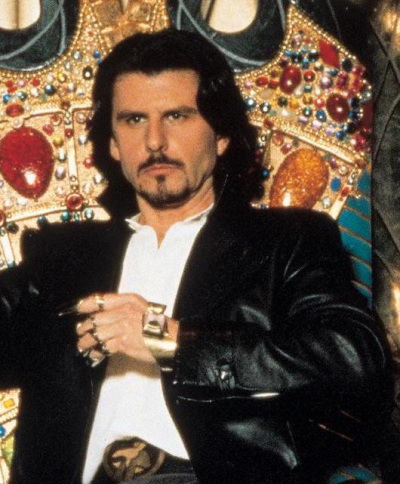
At least He’s handsome!
(I suppose SG-1 deserves credit for not going with the whole “Set is an evil snake God” idea—but wait! The Goa’uld are evil alien snakes! Dammit!)
When people find out that I worship an Egyptian God, they always ask me if I’m a fan of this show for some reason, or if I’m personally offended by it. No, I’m not a fan of Stargate, and I wouldn’t say that I’m “offended” by it either. I do find it a little annoying that Pagan deities are so often depicted in fiction as evil aliens. (Stargate SG-1 even has a Gao’uld character who’s based on a Hindu deity, which seems especially insensitive since the Devas are still worshiped by thousands of people today.) You almost never see this sort of thing done with Jesus; the only exception I can think of is in John Carpenter’s Prince of Darkness (1987), where the J-Man is revealed to have been an extraterrestrial. But aside from this bit of mild annoyance, I don’t think such ideas are really that harmful; I just don’t care for them that much.

